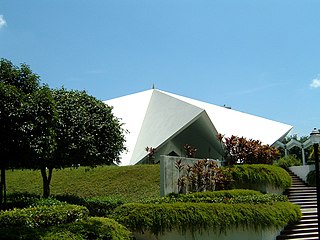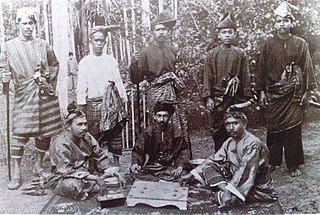Related Research Articles

Pahang, officially Pahang Darul Makmur with the Arabic honorific Darul Makmur is a sultanate and a federal state of Malaysia. It is the third largest state in the country and the largest state in Peninsular Malaysia by area, and ninth largest by population. The state occupies the basin of the Pahang River, and a stretch of the east coast as far south as Endau. Geographically located in the East Coast region of the Peninsular Malaysia, the state shares borders with the Malaysian states of Kelantan and Terengganu to the north, Perak, Selangor and Negeri Sembilan to the west, Johor to the south, while South China Sea is to the east. The Titiwangsa mountain range that forms a natural divider between the peninsula's east and west coasts is spread along the north and south of the state, peaking at Mount Tahan, which is 2,187 metres (7,175 ft) high. Although two thirds of the state is covered by dense rain forest, its central plains are intersected by numerous rivers, and along the coast there is a 32-kilometre (20 mi) wide expanse of alluvial soil that includes the deltas and estuarine plains of the Kuantan, Pahang, Rompin, Endau, and Mersing rivers.

Sultan Haji Ahmad Shah Al-Musta’in Billah ibni Almarhum Sultan Abu Bakar Ri’ayatuddin Al-Mu’azzam Shah was Sultan of Pahang from 1974 until his abdication in 2019, and previously the seventh Yang di-Pertuan Agong, the constitutional monarch of Malaysia from 1979 to 1984. His abdication as Sultan was decided by the Royal Council at an extraordinary meeting on 11 January 2019. A special amendment was passed on the state constitution that gave the body more power for this decision, citing the Sultan's incapability to rule due to his failing health. The abdication announced the next day which was retroactively effective on the day of the Royal Council meeting, paving the way to his son, Abdullah to succeed him as Sultan immediately, and subsequently be elected as the next Yang di-Pertuan Agong later the same month.

Tengku Ampuan Hajah Afzan Rahimahallah binti Almarhum Tengku Panglima Perang Tengku Muhammad was the Malaysian Tengku Ampuan of Pahang. She served as Raja Permaisuri Agong of Malaysia between 26 April 1979 and 25 April 1984.

The Pahang River is a river that mainly flows through the state of Pahang, Malaysia. Its drainage basin covers its namesake state as well as the neighbouring state of Negeri Sembilan.

Federal Route 3 is a main federal road running along the east coast of Peninsula Malaysia. The 739 kilometres (459 mi) federal highway connects Rantau Panjang in Kelantan until Johor Bahru in Johor. The entire FT3 highway is gazetted as a part of the Asian Highway Network route 18.

This article lists important figures and events in Malaysian public affairs during the year 1973, together with births and deaths of notable Malaysians.
Abdul Rahman bin Tuanku Imam Nuh was a nobleman and famous Malay warrior best known for his role in the Pahang Uprising (1891–1895) in Pahang, Malaysia during the period of British protectorate. Dato' Bahaman was an Orang Besar Raja – a fief of the Sultan of Pahang.
Lubuk Paku is a small town in Maran District, Pahang, Malaysia. The town is located near Maran town. The main features of this town are the historical Lubuk Paku police station and Pahang River.

The Abu Bakar Royal Mosque is Pahang's royal mosque which is located in Pekan, Pahang, Malaysia. It was officially opened in 1976 by Sultan Ahmad Shah of Pahang replacing the nearby Abdullah Mosque or Old Royal Mosque.
Kedah Royal Mausoleum or Langgar Royal Mausoleum is a Kedah royal burial grounds. It is located in Langgar, Kota Setar District, Kedah, Malaysia.
The Laluan Penarikan were a series of portage routes across the Malay Peninsula. The most famous of these routes connected the Muar River with the Pahang River. The Penarikan shortened the journey of water vessels sailing between the Strait of Malacca and the South China Sea.
Sri Paduka Dato' Bendahara Sri Maharaja Tun Ali ibni Almarhum Dato' Bendahara Paduka Raja Tun Koris was the 23rd and the last Bendahara of Johor Sultanate, and the fourth Raja Bendahara of the Pahang Kingdom who reigned from 1806 to 1857.

The Pahang Civil War, also known as the Brothers War or the Bendahara War was a civil war fought from 1857 to 1863, between forces loyal to the reigning Raja Bendahara Tun Mutahir, and forces loyal to his brother Tun Ahmad, over the succession to the throne of Pahang.

Pahang Malays are a sub-group of Malay people native to the state of Pahang, in the east coast of Peninsular Malaysia. With population of approximately 1.08 million people, they constitutes 70% of Pahang state's population, making them the dominant ethnic group in the state. Their language, Pahang Malay is one of many Malayan languages spoken in the region that belong to the Malayo-Polynesian group of Austronesian family.

The Pahang Kingdom was a Malay state that existed from 1770 to 1881, and is the immediate predecessor of the modern Malaysian state of Pahang. The kingdom came into existence with the consolidation of power by the Bendahara family in Pahang, following the gradual dismemberment of Johor Empire. A self rule was established in Pahang in the late 18th century, with Tun Abdul Majid declared as the first Raja Bendahara. The area around Pahang formed a part of the hereditary domains attached to this title and administered directly by the Raja Bendahara. The weakening of the Johor sultanate and the disputed succession to the throne was matched by an increasing independence of the great territorial magnates; the Bendahara in Pahang, the Temenggong in Johor and Singapore, and the Yamtuan Muda in Riau.

The Bendahara dynasty is the current ruling dynasty of Pahang, Terengganu and Johor Sultanate, a constituent state of Malaysia. The royal house were of noble origin, holding the hereditary position of Bendahara in the courts of Singapura, Melaka and Old Johor since at least from the end of the 13th century.
Rasu Bin Shahrom, also popularly known as Tok Gajah, was a Malay nobleman of the Pahang Kingdom and its successor, the Pahang Sultanate. He was one of the loyal followers of the then Wan Ahmad, and one of the important figures in the Pahang Civil War. Due to his outstanding gallantry during the war, Rasu rose from the rank of khatib to Imam Perang.

General Zulkiple bin Kassim is a retired Malaysian General who served as 26th Chief of Malaysian Army.

Mat Kilau: Kebangkitan Pahlawan is a 2022 Malaysian Malay-language biographical epic film that is inspired by historical events directed by Syamsul Yusof, starring Adi Putra as Mat Kilau bin Imam Rasu, a Malay warrior who fought the British colonialists during the Pahang Uprising in Pahang, British Malaya before independence. The film features Beto Kusyairy, Fattah Amin, Yayan Ruhian, Geoff Andre Feyaerts and Johan As'ari in supporting roles.
Muhammad Kilau bin Rasu popularly known as 'Mat Kilau', or alternatively known as Mohamed bin Ibrahim or 'Mat Siam', was a local chieftain and folk hero from Pahang, Malaysia, best known for his role in the Pahang Uprising (1891–1895) against the British Empire. The outbreak of the resistance movement in Pahang in the late 19th century was mainly fueled by the grievances among the traditional ruling class towards the British Residential system.
References
- 1 2 Andaya & Andaya 1984 , p. 172
- ↑ Maidin Hussein 2008 , p. 138
- 1 2 Aruna Gopinath 1991 , p. 153
- 1 2 Linehan 1973 , p. 147
- ↑ Linehan 1973 , pp. 144–145
- ↑ Aruna Gopinath 1991 , p. 146
- ↑ Linehan 1973 , p. 152
- 1 2 Aruna Gopinath 1991 , pp. 147–149
- ↑ Linehan 1973 , p. 155
- 1 2 Aruna Gopinath 1991 , p. 156
- 1 2 Aruna Gopinath 1991 , pp. 157–160